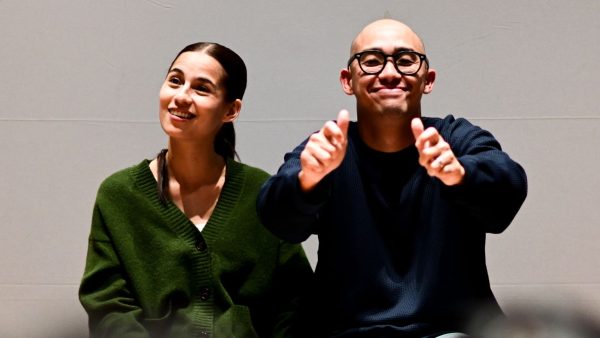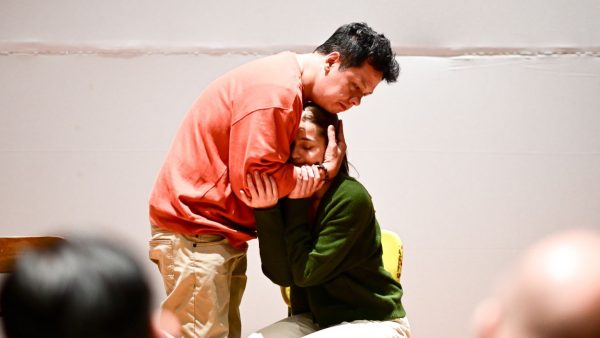
REVIEW: Grief is a relationship in a lively, still-brilliant new run of ‘3 Upuan’
“With a stunning new cast and a striking new venue, the latest version of Guelan Varela-Luarca’s nonlinear play explores loss with an urgent, visceral pulse.”
For both the audience and the artists involved, revisiting a play that’s as deeply personal as Scene Change’s 3 Upuan feels like it could be especially daunting. Already brilliant when it ran in February (and again in August), Guelan Varela-Luarca’s intimate, nonlinear study of three siblings grappling with grief is so delicately put together that it naturally seems to discourage significant overhauls. This latest run has moved from its normally close quarters to the high ceilings of the Ateneo Art Gallery and features an entirely new cast—and thankfully, it has retained every bit of its wisdom and emotional power.
This 3 Upuan is essentially identical to its previous staging, only now its reinterpreted performances and other tweaks give it a more visceral pulse. And thanks to the thoughtfulness of the material, these changes don’t replace the show’s older versions but demonstrate how much the text only continues to accommodate new expressions of grief.
Larger and Livelier
Even if 3 Upuan’s movement to a larger venue makes for a slightly less solemn atmosphere, the artistic team adjusts accordingly—carving out a space within the Ateneo Art Gallery where viewers remain close to the performances, even with fragments of paintings peeking out from the peripheries. Narratively, the location still makes sense for these characters concerned with art and knowledge and the pursuit of truths that might assuage the pain they feel. Among the gallery’s artworks and artifacts, the three siblings’ concerns are naturally placed within an enduring tradition of artistic and historical inquiry. And against a much larger white backdrop, the projections (by Teia Contreras) that display either philosophy lecture slides or wisps of footage from the family’s collective memory seem to expand outward even more.
But there’s still an intense intimacy here from how restricted D Cortezano’s stage actually is; a rectangle of floor space marked by tape and the titular three chairs are all that the actors really have. And yet, Varela-Luarca has made his direction appear livelier and more restless, or he’s simply adjusted how the material glides through its non-traditional structure. Scenes still skip around through irregular intervals of time but now it feels as if the characters are carrying over more emotional residue between each abrupt transition. At a certain point, Jack (Cris Pasturan) breaks the fourth wall and nearly threatens to rush at an off-stage narrator for cueing in each succeeding vignette before he’s had the time to process them.
The Family that Grieves Together
The greater expressiveness of these actors is what most distinguishes this new 3 Upuan. Where the original cast of Martha Comia, Jojit Lorenzo, and JC Santos emphasized the differences that keep the characters apart in their grieving, Pasturan, Jasmine Curtis-Smith, and Paolo O’Hara create a portrait of how familiar and warm the siblings still feel in each other’s company—which is precisely what they’re afraid of ruining if they speak openly about their grief.

Jasmine Curtis-Smith, Cris Pasturan; Photo Credit: Kyle Venturillo
Pasturan’s take on Jack is the most significant departure from a character’s previous portrayal but his angle still captures the same essence. Instead of quietly sinking into defeat, Pasturan uses humor and the irony of Jack’s own lot in life as a defense mechanism—thrashing about in denial that he’s already lost everything.
As older brother Jers, O’Hara doesn’t brandish his intelligence as an authority so much as he does as an approachable friend, even to his students. There’s a charm to his curiosity towards learning, which makes it seem all the more like a betrayal when he runs into an emotional wall he can’t reason around.
And as the youngest sibling, Jai, Curtis-Smith feels everything the most openly—it’s through her that grief’s sheer inconvenience is expressed with all frustration, while her concern for her brothers can’t help but soften (perhaps a little naïvely) at their assurances that they’ll be fine. Her fascination with time becomes inextricable from her relationships; the more she accepts that time answers to no one, the closer she gets to making peace with her grief.
Same Script, New Themes
It’s a credit to how substantial Varela-Luarca’s script is that it can remain almost completely untouched but a change in cast still allows new themes to come to the surface with just as much honesty. Where the individual experience of grief was most prominent in February’s run of 3 Upuan, now the emphasis seems to be placed on how grief structures our relationships. It unites the three siblings in a common experience but disrupts their respective lives that they’ve built with other people. Most painfully, grief calls into question how much we actually know about those we believe we’re close to. As Jai says, we stop telling each other our shames as we get older, in hopes of protecting the bonds formed in childhood.

Paolo O’Hara, Jasmine Curtis-Smith; Photo Credit: Kyle Venturillo
As a result, 3 Upuan’s philosophy lessons, nonlinear storytelling, dance sequence, and other devices aren’t deployed just to make sense of loss but to grasp some sort of understanding of what others around us are going through. Even as it speaks in generally more cerebral language, the play is remarkably generous with its emotions, never cruel or exploitative in its portrayals of death and sadness. And this generosity extends towards the viewers themselves. For those experiencing the show for the first time here, they’re already given a complete, stunningly rich production. For those lucky enough to have been able to afford seeing multiple runs, it only continues to grow with repeat viewings—and always has something to offer, no matter what kind of grief you happen to be tending.
Tickets: P1600
Show Dates: Oct 17–26 2025
Venue: Ateneo Art Gallery, Areté, Ateneo de Manila University, Quezon City
Running Time: approximately 1 hour and 40 minutes (without intermission)
Creatives: Guelan Varela-Luarca (Playwright, Direction), Teia Contreras (Assistant Direction, Video Projection), Anyah Garcia (Movement Design), Katriel Garcia (Movement Design), D Cortezano (Set Design, Lighting Design), Julia Vaila (Sound Design), Nyssa Bianzon (Technical Direction), Maliana Beran (Stage Management)
Cast: Jasmine Curtis-Smith, Paolo O’Hara, Cris Pasturan|
Company: Scene Change


Comments